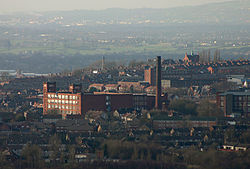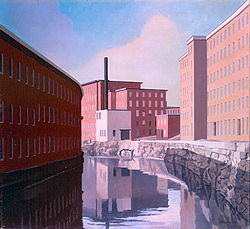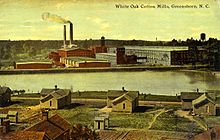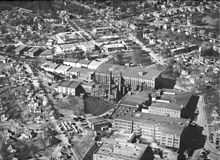- Mill town
-
For places called Milltown, see Milltown (disambiguation)."Mill village" redirects here. For other uses, see Mill Village (disambiguation).
A mill town, also known as factory town or mill village, is typically a settlement that developed around one or more mills or factories (usually cotton mills or factories producing textiles).
Contents
United Kingdom
 Oldham in Greater Manchester, England is an archetypal British "mill town". Although its textile producing days are over, it is still home to many historic cotton mills.
Oldham in Greater Manchester, England is an archetypal British "mill town". Although its textile producing days are over, it is still home to many historic cotton mills.
In the United Kingdom, the term "mill town" often refers to the 19th century textile-manufacturing towns of northern England and the Scottish Lowlands, particularly those in Lancashire (cotton) and Yorkshire (wool). Manchester was bestowed with the name Cottonopolis as its immediate region was considered a metropolis of cotton processing mills. One of the most famous references to the early mills was in the poem/hymn "Jerusalem" by William Blake, in which "those dark satanic mills" were used to symbolise the injustice that a new Jerusalem ought to replace.
The British textile industry never fully recovered after the Great Depression, and its decline continued after the Second World War when it was unable to compete with the growing Indian textile industry. It is said that Gandhi was jeered when he visited mill towns on his 1931 tour of Britain, as many locals blamed his policies for causing unemployment.[1] There are still a minority of mills left in operation today however. In addition, many mill buildings have conservation orders on them, and some have been converted into blocks of flats.
The term mill town has seen something of a revival in the British media since the debate over relations between whites and Asians began in the aftermath of riots in several mill towns.[1][1][1][1] The term conveniently groups together towns on both sides of the Pennines that suffer from sometimes significant racial tension. Many mill towns in northern England are known today as "mill and mosque towns"[1] because of the large amount of British Pakistani Muslims who live there.
Bradford has seen several riots in recent years whilst Burnley, Dewsbury and Oldham have all had suffered one riot each (see Oldham Riots and Bradford Riot). After the Second World War, thousands of migrants from both the Caribbean and the Indian subcontinent settled in the mill towns to fill the labour shortage in the industry; they often moved to the traditional working-class areas whilst the White working-class moved out to the newly built estates after the war.[2]
Many mill towns have a symbol of the textile industry in their town badge. Some towns may also have statues dedicated to textile workers (e.g. Colne [1]) or have a symbol in the badge of local schools (e.g. Ossett School).
The list below includes some towns where textiles was not the predominant industry. For example, mining was also a key industry in Wigan and Leigh in Greater Manchester, and in Ossett in Yorkshire.
Spindleage of major mill towns between 1830 and 1962
Date 1883 1893 1903 1913 1923 1926 1933 1944 1953 1962 Accrington 590 438 467 660 191 718 469 287 152 92 Ashton 1,574 1,731 1,781 1,955 1898 1,144 644 633 182 Blackburn 1,671 1,398 1,321 1,280 1,224 1,071 672 451 309 103 Bolton 4,086 4,770 5,457 6,797 7,371 7,842 7,507 6,204 4,886 1,772 Burnley 1,126 734 667 563 538 507 240 182 144 14 Bury 875 899 833 955 1050 1000 745 630 524 268 Chorley 552 527 541 856 838 837 739 491 397 122 Farnworth 557 779 966 1,485 1,478 1,484 1,344 1,237 1,104 162 Glossop 1,106 1,158 968 882 821 839 524 204 154 10 Heywood 660 887 836 1,070 1,100 1,096 864 545 533 68 Hyde 590 499 533 741 793 696 475 366 337 58 Leigh 1,337 1,514 1,679 2,445 2,761 2,925 2,891 2,615 2,336 548 Manchester 2,445 2,353, 2,225 3,703 3,307 3,439 3,417 2,974 1,934 271 Middleton 498 494 645 1,278 1,268 1,252 1,041 1,193 923 161 Mossley 1,153 1,217 1,033 1,288 1,297 1,289 371 264 256 - Oldham 9,311 11,159 12,230 16,909 17,231 17,669 13,732 8,948 7,621 2,478 Preston 2,146 1,883 2,074 2,161 1,997 1,965 1,592 1,146 1,024 278 Rochdale 1,627 1,835 2,422 3,645 3,749 3,793 3,539 2,459 1,936 983 Stalybridge 1,083 1,157 1,027 1,236 1,104 1,103 801 483 426 122 Stockport 1,601 1,742 1,568 2,266 2,382 1,924 1,427 1,141 154 Wigan 864 775 888 1,085 1,123 1,141 922 681 575 352 In thousands of spindles. [3]
County Towns Cheshire mill towns Derbyshire mill towns Greater Manchester mill towns Ashton-under-Lyne , Bolton , Bury , Chadderton , Failsworth , Heywood , Hyde , Lees , Leigh , Manchester , Middleton , Oldham , Radcliffe , Ramsbottom , Reddish , Rochdale , Royton , Shaw and Crompton , Stalybridge , Stockport , Wigan
Lancashire mill towns Accrington , Bacup , Barnoldswick , Blackburn , Burnley , Calder Vale , Chorley , Colne , Darwen , Nelson , Oakenclough , Padiham , Preston
Yorkshire mill towns Batley , Bingley , Bradford , Brighouse , Cleckheaton , Dewsbury , Elland , Halifax , Hebden Bridge , Heckmondwike , Holmfirth , Huddersfield , Keighley , Morley , Mytholmroyd , Ossett , Pudsey , Shipley , Skipton , Sowerby Bridge , Todmorden , Yeadon
On his tour of northern England in 1849, Scottish publisher Angus Reach said:
In general, these towns wear a monotonous sameness of aspect, physical and moral... In fact, the social condition of the different town populations is almost as much alike as the material appearance of the tall chimneys under which they live. Here and there the height of the latter may differ by a few rounds of brick, but in all essential respects, a description of one is a description of all.[4]—Angus Reach, Morning Chronicle, 1849United States
New England
 Amoskeag Canal, 1948, by Charles Sheeler.
Amoskeag Canal, 1948, by Charles Sheeler.
Beginning with technological information smuggled out of England by Francis Cabot Lowell, large mills were established in New England in the early to mid 19th century. Mill towns, sometimes planned, built and owned as a company town, grew in the shadow of the industries. The region became a manufacturing powerhouse along rivers like the Housatonic River, Quinebaug River, Shetucket River, Blackstone River, Merrimack River, Nashua River, Cochecho River, Saco River, Androscoggin River, Kennebec River or Winooski River.
- "In the nineteenth century, saws and axes made in New England cleared the forests of Ohio; New England ploughs broke the prairie sod, New England scales weighed wheat and meat in Texas; New England serge clothed businessmen in San Francisco; New England cutlery skinned hides to be tanned in Milwaukee and sliced apples to be dried in Missouri; New England whale oil lit lamps across the continent; New England blankets warmed children by night and New England textbooks preached at them by day; New England guns armed the troops; and New England dies, lathes, looms, forges, presses and screwdrivers outfitted factories far and wide." - Jane Jacobs, The Economy of Cities, 1969
In the 20th century, alternatives to water power were developed, and it became more profitable for companies to manufacture textiles in southern states where cotton was grown and winters did not require significant heating costs. Finally, the Great Depression acted as a catalyst that sent several struggling New England firms into bankruptcy.
Mid-Atlantic
State Towns Maryland mill towns Ellicott City , Jerusalem , Oella , Owings Mills , Savage
New Jersey mill towns South
County Towns Alabama mill towns River View, Alabama (Riverdale Mill) , Langdale, Alabama (Langdale Mill) , Fairfax, Alabama (Fairfax Mill) , Shawmut, Alabama (Shawmut Mill) , Lanett, Alabama (Lanett Mill) , Valley, Alabama (Carter/Lanier Mill) , Fairfax, Alabama (Fair View Mill) , Opelika, Alabama (Opelika Mill)
Arkansas mill towns Amity , Delight , Glenwood , Malvern , Mountain Pine
Georgia mill towns Bibb City , Hogansville , New Manchester , Cabbagetown
North Carolina mill towns Burlington , Bynum Canton , Carrboro , Cliffside , Concord , Edgemont (East Durham) , Enka, North Carolina[2] , Glencoe[3] , Haw River , High Shoals , Kannapolis , Long Shoals , McAdenville , Roanoke Rapids , Saxapahaw , Spencer Mountain , Swepsonville , West Durham , West Hillsborough
South Carolina mill towns Cateechee , Central , Cherokee Falls , Fort Mill , Great Falls , Joanna , La France , Lyman , Lockhart , Newry , Olympia and Granby Mills, Columbia , Pacolet Mills , Pelzer , Piedmont , Slater , Ware Shoals , Watts Mills , Whitmire
Sawmill towns
State Towns Wisconsin Eau Claire, Wisconsin Oregon Roseburg, Oregon Illinois Harrisburg, Illinois, Carrier Mills, Illinois South America
Colombia
See also
- Company town
- Industrial district
- Blackstone River Valley National Heritage Corridor
- Old Great Falls Historic District, Paterson, NJ
References
- ^ a b c d e f Vincent Newton, Oldham, British Library Archival Sound Recordings
- ^ The Arrival of the Asian Population, Cotton Town: Your Town, Your History
- ^ *Williams, Mike; Farnie (1992), Cotton Mills of Greater Manchester, Carnegie Publishing, ISBN 0-984789-89-1
- ^ Powell, Rob (1986). In the Wake of King Cotton. Rochdale Art Gallery. p. 12.
External links
Museums and historic sites
- American Textile History Museum, Lowell, MA
- Belknap Mill Society Museum, Laconia, NH
- Slater Mill Historic Site, Pawtucket, RI
- Lowell National Historic Park, Lowell, MA
- Lynn Heritage State Park, Lynn, MA
- The Millyard Museum, Manchester, NH
- Quinebaug & Shetucket Rivers Valley National Historic Corridor
- San Jose de Suaita Cotton Mill Museum
Categories:- Company towns
- Industrial Revolution
- History of the textile industry
Wikimedia Foundation. 2010.



